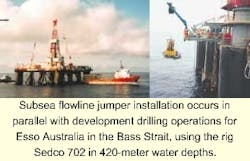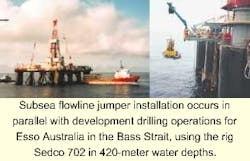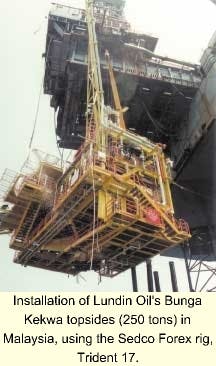MINIMAL PLATFORMS: Using jackup, semisubmersible drilling units to install production structures
With increasing regularity, mobile offshore drilling units (MODU) are being used for more than just drilling wells. This is especially so in the more isolated offshore oil and gas precincts of the world. Jackup units are being used for low-cost minimal platform installations and now semisubmersible rigs are being put to use to reduce subsea construction costs in deepwater developments.
In the North West of Western Australia, all of the 12 small platforms constructed since 1989 have been designed to be installed by jackup drilling rigs. The technique evolved because of the high mobilization costs of construction vessels, which have never been permanently stationed in the region.
In addition, the utilization of low cost pipeline installation techniques based on beach-pulled bottom tows or low cost pipelay barges with minimal lifting capacity has meant that a traditional derrick/pipelay barge cannot be assumed to be available for offshore projects.
Rig installation has since become even more favored as operators have discovered that it offers increased schedule flexibility and lower project risk. The significant advantages are cost reduction, schedule acceleration and flexibility and reduced risk.
Lower cost
Because the jackup rig will be mobilized for the well drilling, there are minimal additional mobilization costs for construction. Jackup rig rates are also typically less than those of a derrick barge. Rig construction activities can use rig resources, such as supply boats to carry the facilities when they are not being used for drilling supply. Furthermore, most well hookup and final construction works can continue during the drilling program, with the rig serving as the support unit for these operations.
The platform substructure can typically be fabricated within three to six months of project commencement, whereas the topsides can typically take 9-12 months, depending on the required process equipment to be supported. If a MODU is used for structure installation, then well drilling and completions can commence before or after substructure installation and can be finished before the topsides are ready.
Substructures and the topsides can be installed as they become available. Fabrication delays can be easily accommodated. This is a far cry from traditional practice where the structures are completely fabricated and installed before the rig arrives to commence drilling the production wells. On the Chevron-operated Roller/Skate project (four structures supporting a total of 9 wells), this allowed the well program and first oil to be accelerated by over six months.
Also, use of the MODU for installation works eliminates the often encountered conflict between the drilling spread and the derrick barge contractor. This can save millions in vessel standby claims, when spread day rates are on the order of A$300,000/day.
Lower risk
The techniques for installation of platforms with a jackup are less risky than those used with derrick barges. Common jackups have up to 500 tons safe lifting capacity and are stable fixed platforms from which piles can be driven or drilled. Jackups do not have to be demobilized from the field during tropical cyclones or during cyclone alerts, therefore minimizing the weather downtime risks during cyclone seasons. After the major lifts have been completed, jackup rig construction can usually continue, regardless of the weather conditions.
Designing platforms, such that they can be installed with jackup rigs, introduces another potential contractor for the offshore installation. In a recent project in South East Asia, the local barge operator offered extremely competitive prices, well below the norm for derrick barge installation, in the face of competition from the jackup installed option.
Three of the Australian platforms that were originally intended for jackup rig installation were ultimately installed by derrick barge as a result of unexpected keen pricing from the only derrick barge operator in the area.
Problem tiebacks
A further advantage of using a jackup drilling rig can be realized in situations where wells have been drilled, suspended at the seabed, and later tied back to a platform. This was the case for the Bunga Kekwa development in Malaysia. In this situation the wells had been drilled by a semisubmersible drilling rig.
Although the wells had been drilled through a seabed template, there was considerable deviation from verticality in the 20-in. casings. The operator elected to use a derrick barge to install the jacket, which docked to the well template. But then, used the drilling rig to perform the well tiebacks prior to that and to install the 250-ton topsides.
This approach gave the rig maximum skidding scope to facilitate the docking of the conductors to the seabed suspensions. Without the topsides in place, there were no restrictions imposed by having to work through small topsides well slots. The rig could skid to whichever position in its drillable area gave the best alignment between new and existing conductors.
After successful mating of the conductors, the rig then skidded the new conductors into their correct alignments to capture the conductor guides. With the topsides lifted by a static and stable jackup rig, it was possible then to lower the topsides over the four well conductors with less than 1 in. of clearance in certain places.
An added advantage of this approach was that the problematic tieback activities were completed by the rig while the topsides were still in fabrication. The greatly accelerated schedule resulted in the completed wells being brought onstream in a very short time after topsides placement.
Different execution
Making a platform suitable for jackup rig installation starts at the project's conceptual design phase. All aspects of platform geometry, weight, transportation method, available rigs, and installation method must be considered in the design. In addition, to reap the full benefit of jackup rig construction, the field development concept can include constructing pipelines without a typical heavy lift crane/pipelay barge.
Low cost pipelay barges and the use of bottom tow can be considered. A specialist consultant should be engaged to assist at this planning phase. The specialist consultant must be well versed in drilling rig operations as well as facilities design, and can thus assist with interface coordination between the drilling and facilities groups.
The operator may have to deviate from a lump sum contracting strategy as the jackup is normally contracted directly by the operator"s drilling group and "free issued" to the installation contractor. Nevertheless, there should still be some form of incentive for the installation contractor to perform. This is a philosophical issue that may also need to be addressed early in the project. Perth-based ICON Engineering has specialized in rig-installed structures and installs it's own designs as well as others that are "rig installable" for specific locations.
A recent example of the technique was the installation in mid-1999 of a single piece platform structure with topsides pre-assembled onto the jacket. The platform, weighing 360 tons, was the first fixed platform to be installed in the Timor Sea, about 500 km northwest of Darwin.
The platform was transported vertically on a barge to tow to location. Installation using the jackup drilling rig allowed the drilling program to be carried out well in advance of the remaining field construction, at a time when jackup rig contractual terms were favorable. ICON performed the engineering.
Semisubmersible construction
In 1999, ICON was able to apply the same logic to Australia's then deepest subsea development (420 meters) in Bass Straight. In this case, a semisubmersible drilling rig was used to carry out the deployment of six flexible flowline jumpers and a number of electrical and hydraulic control umbilicals.
The operator saved the mobilization of an expensive dive support vessel. The rig's support vessels, already on charter, were used for transport of the flowlines. The deployment operations occurred in parallel with development drilling operations and no additional rig time or mobilization cost was incurred. It was found that the large semisubmersible drilling rig allowed the subsea construction work to proceed during rough weather. The semisubmersible's motion characteristics were far better than those of alternative vessels.
In addition to the projects described previously, MODUs have been used for subsea template and manifold installation. There is no technical reason why, for specific applications, they cannot also be effectively used for pipeline installation, diving operations, platform abandonment, and in fact, most activities that are currently undertaken by dedicated construction vessels.
Authors
David Field is a director of ICON Engineering with offshore design and construction experience gained in the North Sea and South East Asia.
Derick Markwell is a director of ICON Engineering and has worked worldwide for offshore design contractors and a major operating company.
Garrick Aberle is a director of ICON Engineering with construction and project management experience throughout Australia and South East Asia.



